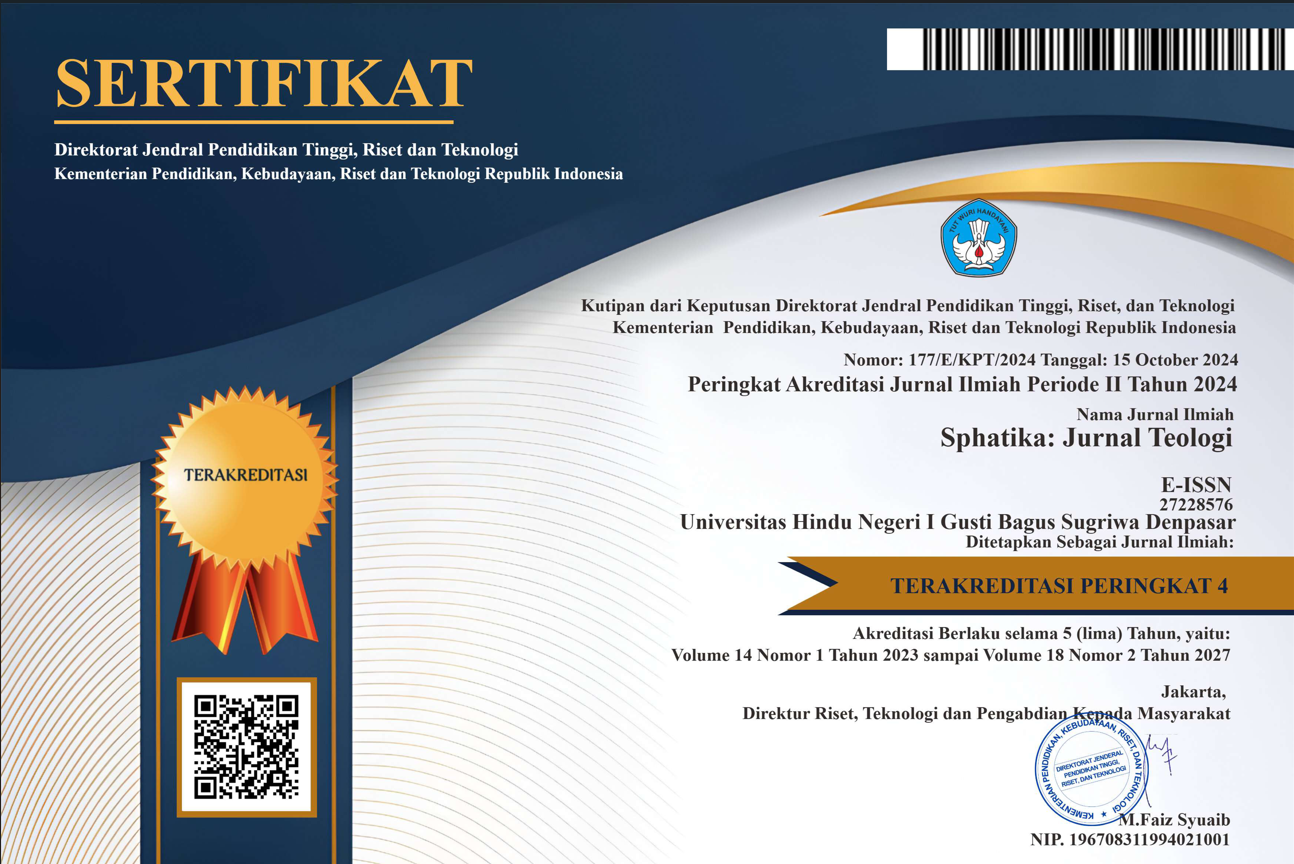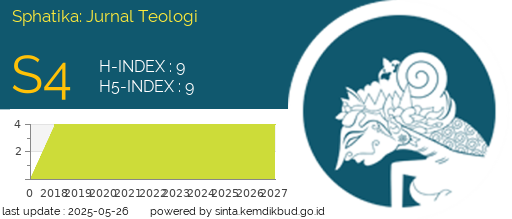Konsep Ista Dewata dalam Lontar Bhuana Sangkṣepa: Sosial Religius Hindu di Bali
DOI:
https://doi.org/10.25078/sphatika.v12i2.1124Keywords:
Bhuana Sangkṣepa; Hindu social religion; Ista DewataAbstract
Hinduism in Indonesia, especially that which was inherited in Bali, is a combination of ancestral beliefs (pre-Hindu) with Vedic teachings that came to the archipelago and blended harmoniously to form sivasiddhanta in Bali. This paper uses two combined theories, namely the theory of hermeneutics, and the theory of symbolic interactionism. The method in collecting data uses the listen-to method, which is combined with basic note-taking techniques. followed by using data analysis methods and techniques which include (1) Data Reduction, (2) Data Presentation, and (3) Verification. It ends with the method of presenting the results of data analysis using an informal method. The text of the Lontar Bhuana Sangkṣepa contains a dialogue between Bhaṭāra Siwa and Bhaṭāri Uma accompanied by Bhaṭāra Kumara. Lontar Bhuana Sangkṣepa consists of 128 Sanskrit Slokas with Old Javanese language, the contents of which explain how to achieve kalepasan with the teachings of Yoga. The concept of the 33 Vedic Gods or what is known as Ista Dewata is transformed into the social religious practice of Hinduism in Bali with the pangider-ider or Dewata Nawa Saga. then those are the forms of grounding the Vedic teachings that can be seen in the practice of Hindu religious life in Bali.
References
Adnyana, Putu Eka Sura. 2020. Karya Prof. Phalgunadi “Sekilas Sejarah Evolusi Agama Hindu”: Menelisik dan Memahaminya dalam Bingkai Filsafat Sejarah Hindu pada jurnal sanjiwani filsafat Vol 2, 2020. Denpasar: IHDN Denpasar.
Blumer H. 1969. Symbolik Interactionism Perspektif and Method.Englewood Cliffs, N.J. : Prentice- Hall, Inc.
Dunia, I Wayan. 2009. Kumpulan Ringkasan Lontar. Surabaya: Paramita.
Faiz, Fakhruddin. 2002. Hermeneutika Al-Qur’an. Yogyakarta: Qolam.
Ismail, Nawari. 2016. Perubahan Sosial-Budaya Komunitas: Agama Dam. Yogyakarta: CV Budi Utama
Phalgunadi, I Gusti Putu. 2006. Sejarah Evolusi Agama Hindu. Denpasar: Widya Dharma.
Radhakrishnan, S. 2008. Upanisad-Upanisad Utama. Surabaya: Paramita.
Siwananda, Sri Swami, 2003. All About Hinduism (Intisasri Ajaran Hindu)-Penerj. Maswinara, Surabaya: Paramita
Sudaryanto. 2015. Metode dan Aneka Teknik Analisis Bahasa: Pengantar Penelitian Wahana Kebudayaan secara Linguistik. Yogyakarta: Sanata Dharma University Press.
Sura, dkk. 1994. Agama Hindu Sebuah Pengantar. Denpasar : CV Kayumas Agung.
Sura. 1999. Siwa Tattwa. Denpasar: Milik Pemerintah Propinsi Bali, Peningkatan Sarana Prasarana Kehidupan Beragama.
Surada, I Made. 2007. Kamus Bahasa Sanskerta - Indonesia. Surabaya: Paramita.
Surada, I Made. 2020. Beberapa Teks Puja Ista Dewata Dalam Pemujaan Umat Hindu Di Bali. Surabaya: Paramitha
Tim Penyusun. 1995. Bhuwana Sang Kṣepa, Sang Hyang Mahājñana, Siwa Tattwa Purāna. Denpasar: Dinas Kebudayaan Provinsi Bali.
Tim Penyusun. 2000. Kamus Sanskerta-Indonesia. Denpasar: Pemerintah Provinsi Bali.
Titib, I Made. 1996. Veda Sabda Suci. Surabaya: Paramitha
Warna, I Wayan dkk. 1991. Kamus Bahasa Bali - Indonesia. Denpasar : Dinas Pendidikan Dasar Propinsi Bali Dati I Bali.
Zoetmulder, P.J. 1983. Kalangwan Sastra Jawa Kuno Selayang Pandang. Penerjemah Dick Hartoko SJ. Jakarta: Djambatan.
Zoetmulder, P.J. 1992. Bahasa Parwa I. Yogyakarta: Gadjah Mada University Press.
Zoetmulder, P.J. dan S.O. Robson. 2004. Kamus Jawa Kuna Indonesia. Penerjemah Darusuprapta dan Sumarti Suprayitna. Jakarta: Gramedia Pustaka Utama.
















